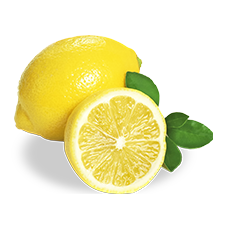Lemon
(Citrus Limon)

| LEMON | ||||||||
| Size | 1 | 2 | 3 | 3 | 4 | 5 | 5 | 6 |
| Diameter (mm) | 73-80 | 69-72 | 66-69 | 63-66 | 59-63 | 56-59 | 53-56 | 50-53 |
| Count 10 KG | 36 | 45 | 54 | 60 | 66 | 72 | 84 | 96 |
| Count 15 KG | 56 | 64 | 75 | 88 | 100 | 113 | 125 | 132 |
| Count 6 KG | 24 | 30 | 36 | 40 | 45 | 48 | 54 | 60 |
This variety is probably a hybrid between the lemon and either an orange or a mandarin, found by F.N. Meyer in 1908. The tree is popular for its small compact size, cold-resistance, and production of fruit year-round (although mostly during the winter and early spring period).
The fruit more closely resembles an orange than a lemon internally as well as externally. It is fairly large – 65 to 75 mm in diameter – almost round in shape and with only the smallest of nipples, usually almost inconspicuous. It has an attractive appearance, with yellowish orange rind which is exceptionally smooth, soft and thin.
The pulp is usually a dark yellow color, very juicy and tender, containing about ten small round seeds per fruit. The flavor is distinct, as if having the sweet lime in its parentage, and it has a lower acid level than the true lemons. This variety is very sensitive to handling damage probably because of its rind texture and soft condition.
Interdonato is considered a lemon-citron hybrid and is said to have originated about 1875 on the property of a Colonel Interdonato in Nizza, Sicily. This is the earliest maturing of lemon varieties in Turkey.
This variety is resistant to mal secco. The tree is moderately vigorous and nearly thornless, with the leaves resembling to some extent those of the citron.
This distinctive variety forms significantly high percentage of Turkey’s lemon crop. The fruit is much larger, longer and smoother than other lemon varieties, with a thin shining rind and a few seeds. Acidity of the juice is lower than most other lemons, although it is still quite acceptable for most culinary purposes.
Rind color is improved by degreening but the tip of the nipple, which is susceptible area on this variety, is invariably turned brown in the process, therefore the treatment should be very sensible. In late December the Interdonato is over mature and is inclined to drop from the tree.
The seeds were imported from Sicily in 1858, and it was introduced as Eureka after two decades in California. It is the most widely grown lemon variety in California, Australia, South Africa and significantly in Argentina.
The tree has a spreading habit but is only moderately vigorous. It has a well distributed harvest season through late winter, spring and early summer. The fruit is well protected from wind blemish and sunburn if the fruit is grown inside the canopy of the tree. Eureka trees are less thorny than Lisbons, making for easier picking than most other lemon varieties.
Rind thickness is medium to thin, and the fruit has a high juice content with a high acid level. Seeds are few, rarely more than five, and often the fruit is seedless.

Named after the town of Lamas, west of Mersin, this well-known Turkish variety forms a significant proportion of the country’s early season lemon production besides Interdonato.
Lamas trees are vigorous, high yielding and come into production at an early age, and are harvested immediately after the Interdonato crop is finished, usually in early November. Fruit is of medium size, almost round in shape with small nipple and neck, with a rind that is smooth and thin, and pulp which is juicy and contains only three to five seeds per fruit. Lamas is perhaps Turkey’s best quality lemon.